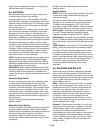
9 -34
Specific Gravity Check
The specific gravity should be checked with a
hydrometer.
NOTE:
The specific gravity should be checked in each
cell and should be the same for all cells. A variation in a
cell reading could be an indication of a problem. Sub-
tract .004 from 1.265 for each 10
o
F below 80
o
F (27
o
C)
or add .004 to 1.265 for each 10
o
F above 80
o
F (27
o
C).
A special temperature compensated hydrometer is
used to read the battery’s state of charge.
The reading on the hydrometer gauge should be above
1.225. If the reading falls below 1.225 specific gravity
there will be an insufficient charge.
ALWAYS charge the battery until the specific gravity of
1.265 is reached over 3 successive readings. Check
monthly to ensure charge is maintained. The
approximate state of charge can be determined by the
cell specific gravity of the rested open circuit voltage at
room temperature and the charging time can be
estimated. For example:
If using an automatic tapering 12 volt charger, choosing
a good quality 5 to 10 amps 15VDC minimum output
charger and charge for 3 to 12 hours according to the
battery state of charge (see table above) or until the
specific gravity in each cell reaches 1.255 - 1.265
specific gravity at 80
o
F (27
o
C).
If using a constant current charger, charge at 1 to 2
amperes for the time given on the table above or until
full specific gravity is reached.
IMPORTANT:
Charging at higher rates will damage the
battery and cause excessive gassing and acid
spewing.
Battery Charger
Under normal conditions the engine alternator will keep
the battery charged. When unit has set for an extended
period of time without operation and the battery has
been completely discharged, a battery charger will be
required for recharging.
Before using a charger, an attempt can be made to
recharge the battery using the engine alternator by
jump starting the unit and allowing the engine to run.
Jump Starting
Jump starting, battery charging, or replacement is
required when the starter motor will not crank the
engine.
The unit used for jump starting should have a 12 volt
battery with at least 500 cold cranking amperes, and a
negatively grounded system.
To jump start the battery:
1. Ensure battery is not frozen. If the fluid is frozen,
remove battery from unit and allow to thaw before
charging.
2. Connect the positive (+) jumper cable to the
positive (+) terminal of the discharged battery.
3. Connect the other end of the same jumper cable to
the positive (+) terminal of the booster battery.
4. Connect one end of the second jumper cable to the
negative (-) terminal of the booster battery.
5. Make the final jumper cable connection to the
engine block or the furthest ground point away
from the discharged battery.
6. Start engine (refer to Owner’s Manual). If engine
will not start after several tries, unit or battery may
need service.
7. After engine starts, leave cables connected for one
to two minutes.
8. Disconnect cables in reverse order.
9. Operate unit as normal to charge battery.
Storage
The battery is a perishable item and it should be stored
properly to obtain a long, useful life. Batteries not in
use will self discharge.
If the battery will not be used for more than three
months, it should be removed and stored in a cool, dry
place.
Any collection of dirt, grease, or electrolyte should be
removed from the top of the battery.
The battery must be recharged monthly or when the
cell specific gravity reads less than 1.255 specific
OCV Specific
Gravity
% of
Charge
Charging
Time
12.60 1.265 100% ---
12.4 1.225 75% 3 hours
12.20 1.180 50% 7 hours
12.00 1.130 25% 10 hours
11.80 1.100 0% 12 hours
WARNING:
FROZEN BATTERIES CAN
EXPLODE and result in death or serious
injury. DO NOT charge a frozen battery. Let
the battery thaw out before putting on a
charger.
UNIT MOVEMENT can result in death or
serious injury. NEVER jump start unit directly
to the starter or starter solenoid. Unit can
move forward or backward and injure the
person jump starting unit.
WARNING:
Make sure cables are clear of any
moving engine parts before starting engine.


















